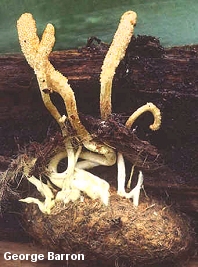ordyceps militaris





Cordyceps militaris is pretty much the coolest mushroom ever, and I will detail its features in a moment--but first I am obliged to discuss CMS, a common problem among mushroom hunters and mycologists. The acronym stands for Cordyceps Moron Syndrome, and symptoms present in two ways. The CMS sufferer 1) plucks any club fungus instantly from its substrate, regardless of what treasures might be found beneath the mushroom, and 2) cannot manage to take a decent photo of a Cordyceps even when the first symptom is bypassed.
The genus Cordyceps consists of clublike parasties that attack underground puffballs or insects. The puffball-parasitizing species are cool enough (see Cordyceps opioglossoidesfor an example, and see the Key to Mycotrophs for a key to 5 North American species), but the bug parasites are astounding. They erupt from insects, bringing to mind the infamous scene in Alien in which John Hurt has a very bad meal.
Cordyceps militaris is the best-known and most frequently collected bug-killing Cordyceps, but there are dozens of "entomogenous" species in North America. The victim forCordyceps militaris is a pupa or larva (usually of a butterfly or moth). Its my celiumcolonizes the living insect and mummifies it, keeping it alive just long enough to generate the biomass it needs to produce the mushroom--a "spore factory" that allows theCordyceps to reproduce.
With Cordyceps militaris the bug is buried in the ground or in well decayed wood, which means the mushroom collector usually sees only a little orange club with a finely pimply surface. Since I suffer from CMS, the one time I found Cordyceps militaris I assumed I was looking at Clavulinopsis laeticolor,took some half-hearted pictures and plucked the thing promptly, without digging up the bug. Fortunately, Andy Methven and George Barron do notsuffer from CMS, and their wonderful photos to the right depictCordyceps militaris in all its murderous glory.
Get this: Cordyceps lloydii (you really need to click the link and see the photos) attacks living ants and secretes a chemical that compels them to climb to the top of the Costa Rican canopy and attach themselves to leaves; then the mushroom erupts from the ant's head or body to disperse spores into wind currents.
Or this: Imagine that Sigourney Weaver and the others, in Alien, could have sensed that John Hurt was infected by an alien parasite, and killed him and quarantined his body rather than sitting down to lunch with him and a secret new shipmate. This is more or less what happens among some ants and termites that have evolved the ability to detect Cordyceps-infected compadres; sentry soldiers guarding the Queen kill the infected insects and take their bodies far from the nest before they can threaten the colony.
Description:
Ecology: Parasitic on buried larvae and pupae of insects (primarily moths and butterflies); growing alone or gregariously; summer and fall; widely distributed in North America but apparently more common east of the Rocky Mountains.
Fruiting Body: 2-8 cm long; up to about .5 cm wide; club-shaped, with the top wider than the base; the upper portion orange and pimply, the lower portion smooth and orange to pale orange, often curved; narrowing at the base and arising from the buried pupa or larva; flesh pale watery orange, with an outer cortex.
Microscopic Features : Perithecia embedded in a layer of loosely interwoven cells; sometimes appearing half-embedded or superficial. Asci 300-510 x 3.5-5 µ, with caps 3.5-5 µ thick. Spores segmented and threadlike; breaking into elliptical segments 2-4.5 x 1-1.5 µ.
REFERENCES: (Linnaeus, 1753) Link, 1833. (Mains, 1958; Smith, Smith & Weber, 1981; Breitenbach & Kr鋘zlin, 1984; Arora, 1986; Phillips, 1991/2005; Lincoff, 1992; Metzler & Metzler, 1992; Barron, 1999; Roody, 2003; McNeil, 2006.) Herb. Kuo 08180607.
Further Online Information:
Cordyceps militaris at Roger's Mushrooms
Cordyceps militarisat Fungi of Poland


 您当前的位置:
您当前的位置:
 沪公网安备31010102008381号
沪公网安备31010102008381号